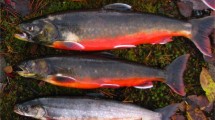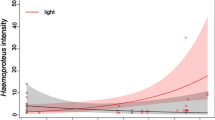Abstract
In the study of parasite-mediated sexual selection, there has been controversial evidence for the prediction that brighter males should have fewer parasites. Most of these studies have focused on one parasite species. Our aim was to investigate the expression of carotenoid-based coloured signals in relation to patterns of multiple parasite infections, to determine whether colour reflects parasite load of all parasite species, or whether different relationships might be found when looking at each parasite species independently. We investigated the relationship between bill colour, body mass and plasma carotenoids and parasite load (feather chewing lice, blood parasite Plasmodium sp., intestinal parasites cestodes and coccidia) in the blackbird (Turdus merula). Bill colour on its own appeared to be a poor predictor of parasite load when investigating its relationships with individual parasite species. Variation in parasite intensities at the community level was summarised using principal component analysis to derive synthetic indexes of relative parasite species abundance and absolute parasite load. The relative abundance of parasite species was strongly related to bill colour, plasma carotenoid levels and body mass: birds with relatively more cestodes and chewing lice and relatively less Plasmodium and coccidia had a more colourful bill, circulated more carotenoids and were heavier. These results suggest that bill colour more accurately reflects the relative intensities of parasite infection, rather than one-by-one relationships with parasites or absolute parasite burden. Investigating patterns of multiple parasite infection would thus improve our understanding of the information conveyed by coloured signals on parasite load.

Similar content being viewed by others
References
Allen PC (1992) Effect of coccidiosis on the distribution of dietary lutein in the chick. Poultry Sci 71(9):1457–1463
Allen PC (1997a) Nitric oxide production during Eimeria tenella infections in chickens. Poultry Sci 76(6):810–813
Allen PC (1997b) Production of free radical species during Eimeria maxima infections in chickens. Poultry Sci 76(6):814–821
Alonso-Alvarez C, Bertrand S, Devevey GL, Gaillard M, Prost J, Faivre B, Sorci G (2004) An experimental test of the dose-dependent effect of carotenoids and immune activation on sexual signals and antioxidant activity. Am Nat 164(5):651–659
Baeta R, Faivre B, Motreuil S, Gaillard M, Moreau J (2008) Carotenoid trade-off between parasitic resistance and sexual display: an experimental study in the blackbird (Turdus merula). Proc R Soc B 275:427–434
Barroca M (2005) Hétérogénéité des relations parasites - oiseaux : importance écologique et role évolutif. Ph.D. Thesis, Université de Bourgogne
Bendich A (1993) Physiological roles of antioxidants in the immune system. J Dairy Sci 76(9):2789–2794
Bennett G, Bishop M, Peirce M (1993) Checklist of the avian species of Plasmodium Marchiafava & Celli, 1885 (Apicomplexa) and their distribution by avian family and Wallacean life zones. Syst Parasitol 26(3):171–179
Bentz S, Rigaud T, Barroca M, Martin-Laurent F, Bru D, Moreau J, Faivre B (2006) Sensitive measure of prevalence and parasitaemia of haemosporidia from European blackbird (Turdus merula) populations: value of PCR-RFLP and quantitative PCR. Parasitology 133:685–692
Biard C, Hardy C, Motreuil S, Moreau J (2009) Dynamics of PHA-induced immune response and plasma carotenoids in birds: should we have a closer look? J Exp Biol 212(9):1336–1343
Blount JD, Houston DC, Møller AP, Wright J (2003a) Do individual branches of immune defence correlate? A comparative case study of scavenging and non-scavenging birds. Oikos 102:340–350
Blount JD, Metcalfe NB, Birkhead TR, Surai PF (2003b) Carotenoid modulation of immune function and sexual attractiveness in zebra finches. Science 300:125–127
Bright A, Waas JR (2002) Effects of bill pigmentation and UV reflectance during territory establishment in blackbirds. Anim Behav 64:207–213
Bright A, Waas JR, King CM, Cuming PD (2004) Bill colour and correlates of male quality in blackbirds: an analysis using canonical ordination. Behav Processes 65:123–132
Candolin U (2003) The use of multiple cues in mate choice. Biol Rev 78:575–595
Clayton DH, Walther BA (1997) Collection and quantification of arthropod parasites of birds. In: Clayton DH, Moore J (eds) Host–parasite evolution: General principles and avian models. Oxford University Press, Oxford, U.K., pp 419–440
Costa FJ, Macedo RH (2005) Coccidian oocyst parasitism in the blue-black grassquit: influence on secondary sex ornaments and body condition. Anim Behav 70:1401–1409
Costantini D (2008) Oxidative stress in ecology and evolution: lessons from avian studies. Ecol Lett 11:1238–1251
Costantini D, Dell’Omo G (2006) Effects of T-cell-mediated immune response on avian oxidative stress. Comp Biochem Physiol A 145:137–142
Cox FEG (2001) Concomitant infections, parasites and immune responses. Parasitology 122(Supplement S1):S23–S38
Das BS, Thurnham DI, Das DB (1996) Plasma alpha-tocopherol, retinol, and carotenoids in children with falciparum malaria. Am J Clin Nutr 64(1):94–100
Dawson RD, Bortolotti GR (2006) Carotenoid-dependent coloration of male American kestrels predicts ability to reduce parasitic infections. Naturwissenschaften 93:587–602
Edge R, McGarvey DJ, Truscott TG (1997) The carotenoids as anti-oxidants—a review. J Photochem Photobiol B 41(3):189–200
Faivre B, Préault M, Théry M, Secondi J, Patris B, Cézilly F (2001) Breeding strategy and morphological characters in an urban population of blackbirds, Turdus merula. Anim Behav 61:969–974
Faivre B, Grégoire A, Préault M, Cézilly F, Sorci G (2003a) Immune activation rapidly mirrored in a secondary sexual trait. Science 300:103
Faivre B, Préault M, Salvadori F, Théry M, Gaillard M, Cézilly F (2003b) Bill colour and immunocompetence in the European blackbird. Anim Behav 65:1125–1131
Figuerola J, Torres J, Garrido J, Green AJ, Negro JJ (2005) Do carotenoids and spleen size vary with helminth load in greylag geese? Can J Zool 83:389–395
Filipiak L, Mathieu F, Moreau J (2009) Caution on the assessment of intestinal parasitic load in studying parasite-mediated sexual selection: the case of Blackbirds coccidiosis. Int J Parasitol 39(6):741–746
Gautier P, Barroca M, Bertrand S, Eraud C, Gaillard M, Hammam M, Motreuil S, Sorci G, Faivre B (2008) The presence of females modulates the expression of a carotenoid-based sexual signal. Behav Ecol Sociobiol 62:1159–1166
Goüy de Belloq J, Ribas A, Casanova JC, Morand S (2007) Immunocompetence and helminth community of the white-toothed shrew, Crocidura russula from the Montseny Natural Park, Spain. Eur J Wildl Res 53:315–320
Grégoire A, Faivre B, Heeb P, Cézilly F (2002) A comparison of infestation patterns by Ixodes ticks in urban and rural populations of the Common Blackbird Turdus merula. Ibis 144:640–645
Hamilton WD, Zuk M (1982) Heritable true fitness and bright birds: a role for parasites? Science 218:384–387
Hatchwell BJ, Wood MJ, Anwar M, Perrins CM (2000) The prevalence and ecology of the haematozoan parasites of European blackbirds Turdus merula. Can J Zool 78:684–687
Hatchwell BJ, Wood MJ, Anwar MA, Chamberlain DE, Perrins CM (2001) The haematozoan parasites of Common Blackbirds Turdus merula: associations with host condition. Ibis 143(3):420–426
Hill GE (2006) Environmental regulation of ornamental coloration. In: Hill GE, McGraw KJ (eds) Bird coloration 1 mechanisms and measurements. Harvard University Press, Harvard, pp 507–560
Hill GE, McGraw KJ (eds) (2006) Bird coloration. 1. Mechanisms and measurements. Harvard University Press, Harvard
Holmstad PR, Skorping A (1998) Covariation of parasite intensities in willow ptarmigan, Lagopus lagopus L. Can J Zool 76:1581–1588
Holmstad PR, Jensen KH, Skorping A (2008) Ectoparasite intensities are correlated with endoparasite infection loads in willow ptarmigan. Oikos 117:515–520
Hõrak P, Ots I, Vellau H, Spottiswoode C, Møller AP (2001) Carotenoid-based plumage coloration reflects hemoparasite infection and local survival in breeding great tits. Oecologia 126:166–173
Hõrak P, Saks L, Karu U, Ots I, Surai PF, McGraw KJ (2004a) How coccidian parasites affect health and appearance of greenfinches. J Anim Ecol 73:935–947
Hõrak P, Surai PF, Ots I, Møller AP (2004b) Fat soluble antioxidants in brood-rearing great tits: relations to health and appearance. J Avian Biol 35:63–70
Hõrak P, Zilmer M, Saks L, Ots I, Karu U, Zilmer K (2006) Antioxidant protection, carotenoids and the costs of immune challenge in greenfinches. J Exp Biol 209:4329–4338
Koutsos EA, Calvert CC, Klasing KC (2003) The effect of an acute phase response on tissue carotenoid levels of growing chickens (Gallus gallus domesticus). Comp Biochem Physiol A 135:635–646
Kruszewicz A, Dyrcz A (2000) Intestinal parasites in five bird species of the genus Acrocephalus. Acta Ornithol 35(2):153–158
Lessells CM, Boag PT (1987) Unrepeatable repetabilities: a common mistake. Auk 104:116–121
Lozano GA (1994) Carotenoids, parasites, and sexual selection. Oikos 70(2):309–311
Masvaer M, Liljedal S, Folstad I (2004) Are secondary sex traits, parasites and immunity related to variation in primary sex traits in the Arctic charr? Proc R Soc B 271:S40–S42
Mazgajski TD, Kedra AH (1998) Endoparasite Isospora sp. (Coccidia, Eimeriidae) affects the growth of starling Sturnus vulgaris nestling. Acta Parasitol 43(4):214–216
McGraw KJ, Ardia DR (2003) Carotenoids, immunocompetence, and the information content of sexual colors: an experimental test. Am Nat 162(6):704–712
Metzger A, Mukasa G, Shankar AH, Ndeezi G, Melikian G, Semba RD (2001) Antioxidant status and acute malaria in children in Kampala, Uganda. Am J Trop Med Hyg 65(2):115–119
Møller AP, Christe P, Lux E (1999) Parasitism, host immune function and sexual selection. Q Rev Biol 74(1):3–20
Møller AP, Biard C, Blount JD, Houston DC, Ninni P, Saino N, Surai PF (2000) Carotenoid-dependant signals: Indicators of foraging efficiency, immunocompetence or detoxification ability ? Avian Poult Biol Rev 11(3):137–159
Moran MD (2003) Arguments for rejecting the sequential Bonferroni in ecological studies. Oikos 100(2):403–405
Mougeot F, Pérez-Rodríguez L, Sumozas N, Terraube J (2009) Parasites, condition, immune responsiveness and carotenoid-based ornamentation in male red-legged partridge Alectoris rufa. J Avian Biol 40:67–74
Nakagawa S (2004) A farewell to Bonferroni: the problems of low statistical power and publication bias. Behav Ecol 15(6):1044–1045
Nussenblatt V, Mukasa G, Metzger A, Ndeezi G, Eisinger W, Semba RD (2002) Relationship between carotenoids and anaemia during acute uncomplicated Plasmodium falciparum malaria in children. J Health Popul Nutr 20(3):205–214
Pérez-Rodríguez L, Viñuela J (2008) Carotenoid-based bill and eye ring coloration as honest signals of condition: an experimental test in the red-legged partridge (Alectoris rufa). Naturwissenschaften 95:821–830
Pérez-Rodríguez L, Mougeot F, Alonso-Alvarez C, Blas J, Viñuela J, Bortolotti GR (2008) Cell-mediated immune activation rapidly decreases plasma carotenoids but does not affect oxidative stress in red-legged partridges (Alectoris rufa). J Exp Biol 211:2155–2161
Peters A, Delhey K, Denk AG, Kempenaers B (2004) Trade-offs between immune investment and sexual signalling in male mallards. Am Nat 164(1):51–59
Roulin A, Christe P, Dijkstra C, Ducrest A-L, Jungi T (2007) Origin-related, environmental, sex, and age determinants of immunocompetence, susceptibility to ectoparasites, and disease symptoms in the barn owl. Biol J Linn Soc 90:703–718
Shykoff JA, Widmer A (1996) Parasites and carotenoid-based signal intensity: how general should the relationship be? Naturwissenschaften 83(3):113–121
Ternengo S, Levron C, Desideri F, Marchand B (2005) Parasite communities in european eels Anguilla anguilla (Pisces, Teleostei) from a corsican coastal pond. Vie et Milieu 55(1):1–6
Vainikka A, Taskinen J, Löytynoja K, Jokinen EI, Kortet R (2009) Measured immunocompetence relates to the proportion of dead parasites in a wild roach population. Funct Ecol 23(1):187–195
Valkiunias G (2005) Avian malaria parasites and other Haemasporidae. CRC, New York
Yun CH, Lillehoj HS, Lillehoj EP (2000) Intestinal immune responses to coccidiosis. Dev Comp Immunol 24(2–3):303–324
Acknowledgments
We thank Yannick Moret and anonymous referees for helpful comments on the manuscript. We are particularly grateful to Monique Prost for help with identification of Phthiraptera. We thank the city of Dijon for authorizations.
Author information
Authors and Affiliations
Corresponding author
Rights and permissions
About this article
Cite this article
Biard, C., Saulnier, N., Gaillard, M. et al. Carotenoid-based bill colour is an integrative signal of multiple parasite infection in blackbird. Naturwissenschaften 97, 987–995 (2010). https://doi.org/10.1007/s00114-010-0716-5
Received:
Revised:
Accepted:
Published:
Issue Date:
DOI: https://doi.org/10.1007/s00114-010-0716-5




